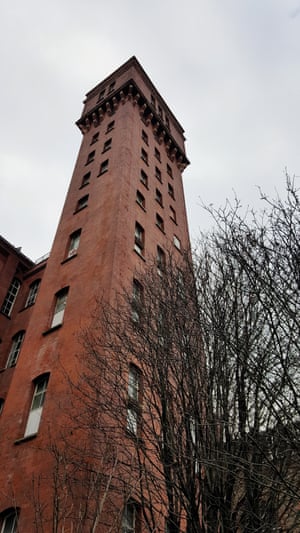
Charles Saumarez Smith, that’s who. The secretary and chief executive of the Royal Academy of Arts, owner of a double-fronted Georgian house in Stepney – before that a terrace house in Limehouse, bought in 1982 – lets you know in the very first sentence of his book on east London, with lack of cant, that he is not your traditional cockney diamond geezer.

Victorian cottages off Deal Street, Spitalfields, photographed by Charles Saumarez Smith: ‘You don’t see the clutter of phone shops and fried-chicken outlets that make up much of the landscape.’ Photograph: thameshudson
“I began to explore east London in 1971,” he opens, “when I was teaching English and mathematics at Westminster Abbey choir school.” He is proud to take pleasure in “Verde & Company, run by Harvey Cabaniss, a supplier of Pierre Marcolini chocolates – the best chocolates in the world”; also in “Ruby Violet’s handmade ice-cream” at the short-lived Wapping farmers’ market; in the “good source of almonds, cheese and organic vegetables” that is Leila’s Shop in Shoreditch. “Best of all was the terrine and coriander hummus”, in a cafe in Hackney Wick.

The Mission, Limehouse, in another picture Charles Saumarez Smith took on his phone.
Briefly, as the book doesn’t want to be social or political, he considers the G-word and comes to its defence: “I respect the process of change”, such as “the ways in which Spitalfields has been transformed from an area of downbeaten houses into an epicentre of fashion”. He moves on, describing the walks he takes around the fabled, tumultuous East End, the place that ingrained itself in the national psyche and conscience – alternately an orphan child in a Victorian melodrama and a black-and-white movie ruffian – as a place of want, spirit and disorder.
But the East End of slums, docks, bombs, gangs, riots and revolutionaries is mostly not Saumarez Smith’s. He approaches it more with the eye of the architectural historian that he is by training, spotting Venetian arches and carved putti, walls of Kentish ragstone or knapped flint, a “good example of 1950s ecclesiasticism”, and “good terracotta detailing”.
He sees churches, graveyards, classical squares, Victorian civic institutions, almshouses and philanthropic housing. He dwells with particular delight on Nicholas Hawksmoor’s sepulchral white churches. There are glimpses of the new East End of Canary Wharf, a mild rebuke to the Queen Elizabeth Olympic Park (“too much clutter”) and faint praise for the ArcelorMittal Orbit(it “looks better close up”). He notes monuments of brutalist housing: Ernő Goldfinger’s “monumental, if bleak” Balfron Tower, and Peter and Alison Smithson’s Robin Hood Gardens, soon to be demolished, “no more gloomy – in fact, much less so – than the rest of Poplar”. “As the years go by,” he muses, “I become less hostile to the big Corbusian housing estates.”
Briefly, as the book doesn’t want to be social or political, he considers the G-word and comes to its defence: “I respect the process of change”, such as “the ways in which Spitalfields has been transformed from an area of downbeaten houses into an epicentre of fashion”. He moves on, describing the walks he takes around the fabled, tumultuous East End, the place that ingrained itself in the national psyche and conscience – alternately an orphan child in a Victorian melodrama and a black-and-white movie ruffian – as a place of want, spirit and disorder.
But the East End of slums, docks, bombs, gangs, riots and revolutionaries is mostly not Saumarez Smith’s. He approaches it more with the eye of the architectural historian that he is by training, spotting Venetian arches and carved putti, walls of Kentish ragstone or knapped flint, a “good example of 1950s ecclesiasticism”, and “good terracotta detailing”.
He sees churches, graveyards, classical squares, Victorian civic institutions, almshouses and philanthropic housing. He dwells with particular delight on Nicholas Hawksmoor’s sepulchral white churches. There are glimpses of the new East End of Canary Wharf, a mild rebuke to the Queen Elizabeth Olympic Park (“too much clutter”) and faint praise for the ArcelorMittal Orbit(it “looks better close up”). He notes monuments of brutalist housing: Ernő Goldfinger’s “monumental, if bleak” Balfron Tower, and Peter and Alison Smithson’s Robin Hood Gardens, soon to be demolished, “no more gloomy – in fact, much less so – than the rest of Poplar”. “As the years go by,” he muses, “I become less hostile to the big Corbusian housing estates.”

The spire of Christ Church, Spitalfields.
The book being derived from a blog, the tone is personal, erudition mixed with anecdote, and great monuments with the rooms of friends’ houses and Saumarez Smith’s own. There are the tales of delectable foodstuffs. There are little riffs, such as one on the Cereal Killer cafe, scene of anti-hipster protests, which sells breakfast cereal at high-ish prices and leads Saumarez Smith, via the discovery that John Harvey Kellogg invented cornflakes for their supposed anti-libidinous properties, to an arresting reflection: “I can’t see why anyone would want to masturbate at breakfast.”
There are historical nuggets, such as Lenin and Stalin’s appearances in the area as exiled would-be revolutionaries, although surprisingly no mention of the Cable Street anti-fascist riots and the mural that remembers them. There is a touching description, conceivably self-parodic, of a night out at the restored but still crumbly Wilton’s Music Hall, “a performance of L’Ospedale, a hitherto unknown mid-17th-century opera by an obscure composer on the problems of 17th-century medicine, updated as a commentary upon the NHS: a production by a young and newly formed musical collective called
The book being derived from a blog, the tone is personal, erudition mixed with anecdote, and great monuments with the rooms of friends’ houses and Saumarez Smith’s own. There are the tales of delectable foodstuffs. There are little riffs, such as one on the Cereal Killer cafe, scene of anti-hipster protests, which sells breakfast cereal at high-ish prices and leads Saumarez Smith, via the discovery that John Harvey Kellogg invented cornflakes for their supposed anti-libidinous properties, to an arresting reflection: “I can’t see why anyone would want to masturbate at breakfast.”
There are historical nuggets, such as Lenin and Stalin’s appearances in the area as exiled would-be revolutionaries, although surprisingly no mention of the Cable Street anti-fascist riots and the mural that remembers them. There is a touching description, conceivably self-parodic, of a night out at the restored but still crumbly Wilton’s Music Hall, “a performance of L’Ospedale, a hitherto unknown mid-17th-century opera by an obscure composer on the problems of 17th-century medicine, updated as a commentary upon the NHS: a production by a young and newly formed musical collective called
Solomon’s Knot.
”

The Bryant & May factory at Bow. Photograph: thameshudson
The many photographs are taken on the author’s phone. Crisp, bright and densely toned, they advertise its abilities in a way that would make Apple proud. They tend to be sunny and unpopulated and screen out most of the ugly, messy stuff. You don’t see much of the new Shenzhen of housing towers in Stratford, nor the clutter of phone shops and fried-chicken outlets that make up much of the landscape.
Saumarez Smith is not Iain Sinclair, who would scrutinise these same blocks and pavements for occult meaning, nor Peter Ackroyd, on the hunt for claggy doom. He’s not quite Ian Nairn, whose assessments in his now-classic guide to London were more visceral and metaphorical: calling a church window “fungoid” is the nearest Saumarez Smith gets. The tone is more like that of Pevsner’s Buildings of England guides, but with the subjective comment knob turned up and the academic one turned down. He uses the vocabulary of connoisseurial discrimination: “fine”, “very fine”, “good and interesting”, “surprising”, sometimes “odd”.
The overall effect is of an alternative East End universe, a bit more Georgian than the one we have now, more architectural, more charming, almost bucolic in its combinations of leafy waterways and cemeteries with ancient buildings. If you want social realism or deep analysis of the complexities of gentrification, look elsewhere. Instead we have a book palpably good-natured and benign, avowedly personal. Making no claims to change the world, it just wants to enjoy it.
•
No comments:
Post a Comment